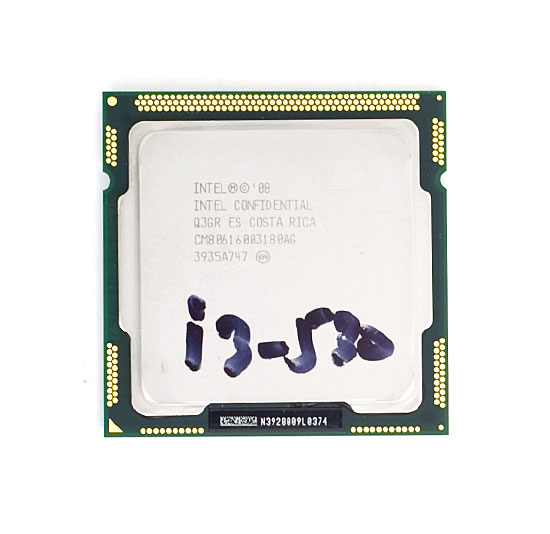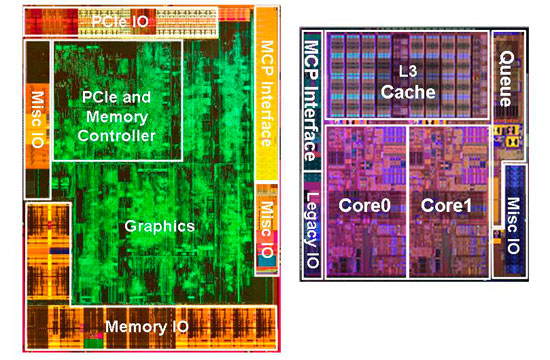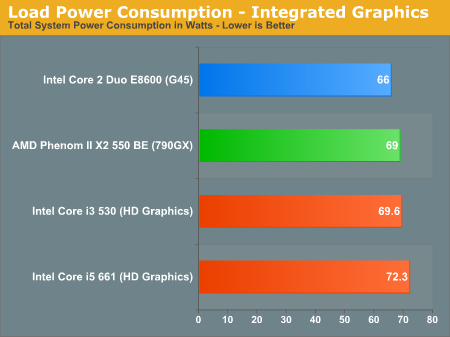The Intel Core i3 530 Review - Great for Overclockers & Gamers
by Anand Lal Shimpi on January 22, 2010 12:00 AM EST- Posted in
- CPUs
It’s about time we got an interesting value processor to review from Intel. I simulated one in our Clarkdale review, but today I’m bringing you a full review of the most interesting dual-core Westmere for the desktop - the Core i3 530.

Priced at $113 (and selling for about $125 on the street) the 530 runs at 2.93GHz and features no turbo modes. It’ll run at 1.33GHz at its lowest frequency, and no faster than 2.93GHz at full load. The missing turbo boost is almost all you sacrifice as the 530 still has a hefty 4MB L3 cache shared between both cores. Each core gets a 256KB 10-cycle L2, just like the i5s and i7s.
The un-core is clocked at 2.13GHz, down from 2.40GHz in the i5. That should hurt performance a bit compared to our simulated i3 in the launch article. Aside from Turbo the other thing you give up with the i3 is AES acceleration. Westmere's AES New Instructions (AES-NI) are disabled on all of the i3s in typical Intel fashion. There has to be some reason for users to opt for a Core i5 instead.
| Processor | Core | Un-core | GPU | Cores / Threads | L3 Cache | Max Turbo | TDP | Price |
| Intel Core i5-670 | 3.46GHz | 2.40GHz | 733MHz | 2 / 4 | 4MB | 3.76GHz | 73W | $284 |
| Intel Core i5-661 | 3.33GHz | 2.40GHz | 900MHz | 2 / 4 | 4MB | 3.60GHz | 87W | $196 |
| Intel Core i5-660 | 3.33GHz | 2.40GHz | 733MHz | 2 / 4 | 4MB | 3.60GHz | 73W | $196 |
| Intel Core i5-650 | 3.20GHz | 2.40GHz | 733MHz | 2 / 4 | 4MB | 3.46GHz | 73W | $176 |
| Intel Core i3-540 | 3.06GHz | 2.13GHz | 733MHz | 2 / 4 | 4MB | N/A | 73W | $133 |
| Intel Core i3-530 | 2.93GHz | 2.13GHz | 733MHz | 2 / 4 | 4MB | N/A | 73W | $113 |
| Intel Pentium G9650 | 2.80GHz | 2.00GHz | 533MHz | 2 / 2 | 3MB | N/A | 73W | $87 |
Sitting next to the 32nm CPU die is a 45nm GPU/memory controller:

Like the majority of the Core i5 processors, the GPU here runs at 733MHz. The exception being our recently reviewed 661 which runs the GPU at 900MHz for those who want that extra bit of mediocre gaming performance.
From Intel the closest competitor is the Core 2 Duo E7600, which runs at 3.06GHz but with a 3MB L2 cache. AMD provides the biggest threat with its Athlon II X4 630 and Phenom II X2 550 BE. The latter isn't on AMD's official price list but you can still find it online today for $99.
In a market full of good alternatives, whether it’s an ultra-cheap quad-core or a solid dual-core, it’s time to find out if there’s any value in the Core i3 530.
Fixes Since Last Time
There were two outstanding issues in our Clarkdale review that needed fixing after CES. First and foremost was power consumption. We incorrectly assumed that Clarkdale's idle power consumption was worse than Lynnfield due to the 45nm on-package chipset. As many of you pointed out, it was an issue with our ASUS H57 motherboard. After CES we switched over to Gigabyte's GA-HS57M-USB3 and the idle power consumption improved considerably. Since then ASUS appears to have fixed the problem but our data for this review was still run with Gigabyte's board.

Unfortunately these sorts of issues aren't rare with any new motherboard/chipset release. Our ASUS H57 board had idle power issues, while our Gigabyte H57 board had overclocking issues. No one seems to get it right on the first try.
The second issue that needs correcting is the system power consumption while playing back an x264 video using integrated graphics. Our AMD numbers were unusually high in our initial review, which we've since corrected:

While playing H.264 encoded video the GPU does all of the heavy lifting and there's no power advantage for Clarkdale to rest on. When watching a movie the AMD system is indistinguishable from our Clarkdale test bed.
We are still running into an issue with MPC-HC and video corruption with DXVA enabled on the 790GX, but haven't been able to fix it yet. Have any of you had issues with video corruption with AMD graphics and the latest stable build of MPC-HC for 64-bit Windows? Or should we chalk it up to being just another day in the AnandTech labs.










107 Comments
View All Comments
Suntan - Friday, January 22, 2010 - link
Then again, it may just be that those people do have better stereos (or more importantly, better rooms and speakers) then yours.In any case, 99% of this website’s existence is possible because of the tendency for people to try and get “just a little more” out of their electronics…
-Suntan
Suntan - Friday, January 22, 2010 - link
In a word, yes. If your room/components/setup is worth it, then it can make a big difference.Analog output (and no, what you are doing is not LPCM) can compete sound-wise with digital output (either LPCM or bit streaming) if you have a quality soundcard (think Lynx 2B, not anything that says soundblaster) but even then, you lose other digital signal processing capabilities that a good AVR can offer (namely Audyssey Multi-EQ room correction and Audyessey Dynamic-EQ.)
That said, I too think it is a little over exaggerated. Simply because most people really wouldn’t notice the benefit in their situations.
Lastly, I happen to believe that the big flap over LPCM vs. bitstream *is* completely overblown. Ymmv.
-Suntan
Anand Lal Shimpi - Friday, January 22, 2010 - link
I agree that 8-channel LPCM is pretty much good enough. There are issues with players downsampling audio when outputting 8-channel LPCM from TrueHD/DTS-HD MA sources, but to my ears I could never notice the difference.Also remember that the majority of users don't even have 8-channel audio setups. We're talking 5.1 at best, and honestly a huge advantage of these high def audio formats is the support for discrete rear surround channels.
That being said, it's still a valid option to want. Blu-ray players have been able to do it for quite a while, there's no reason we shouldn't demand the same out of our HTPCs. Some users do prefer to keep the decoding on their receiver/preprocessor and for them it's the only option.
Hopefully by the end of this year all platforms will offer it and we can just assume its presence as a checkbox feature.
Take care,
Anand
cmdrdredd - Friday, January 22, 2010 - link
The big problem is some players mess with the audio during the decode and don't output LPCM in a raw untouched format. Bitstreaming means nothing is meddes with, no volume normalization and the like.archcommus - Friday, January 22, 2010 - link
Thanks all for the info, helped clear things up. With my 5.1 system and onboard audio with Windows 7 these days the software decoding and analog output is fine. But I guess in the future with a possible 7.1 system I would at least want LPCM over HDMI. I couldn't imagine needing bitstreaming unless I was building a true home theater.Spivonious - Friday, January 22, 2010 - link
LPCM is decoding the channels and sending them digitally over HDMI.I don't understand the big hype either, unless the decoder in your AVR is much better than the one in software. Otherwise the sound would be the same. I guess it's fun to get the AVR to display "DTS-HD".
blckgrffn - Friday, January 22, 2010 - link
Can we see what the 4ghz power consumption looked like? Was speed step still active? How about the OC'd graphics power consumption?Thanks :)
Anand Lal Shimpi - Friday, January 22, 2010 - link
At 4GHz the i3 530 used 129W under load, up from 101.4W :)I don't remember if speedstep was still functioning when I adjusted the clock multiplier, I believe it was but I'll need to double check.
Take care,
Anand
blckgrffn - Saturday, January 23, 2010 - link
Thank you!I guess it doesn't matter if speedstep was functioning if you could provide the idle power consumption of 4ghz as well.
The information is very much appreciated.
Deaks2 - Friday, January 22, 2010 - link
So were the the overclocking tests done on the Asus or MSI mainboard? Also, would the use of a P55 or H55 chipset affect o/c'ability of this CPU?